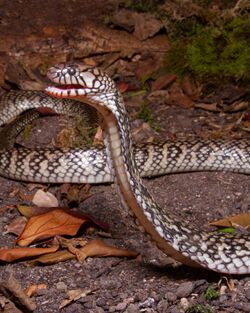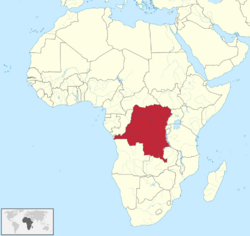Biology:Dwarf water cobra
| Dwarf water cobra | |
|---|---|

| |
| Scientific classification | |
| Domain: | Eukaryota |
| Kingdom: | Animalia |
| Phylum: | Chordata |
| Class: | Reptilia |
| Order: | Squamata |
| Suborder: | Serpentes |
| Family: | Elapidae |
| Genus: | Naja |
| Subgenus: | Boulengerina |
| Species: | N. nana
|
| Binomial name | |
| Naja nana Collet & Trape, 2020[1]
| |

| |
| Distribution of the dwarf water cobra | |
The dwarf water cobra (Naja nana) is a small, venomous species of aquatic cobra found in the Democratic Republic of Congo (Katanga). It was first described by Marcel Collet and Jean-Francois Trape in 2020, based on two specimens from Lake Mai-Ndombe.
Taxonomy
Naja nana is classified under the genus Naja of the family Elapidae, and considered a member of the Boulengerina subgenus, along with related species such as Naja annulata, Naja christyi, and Naja melanoleuca. The genus name Naja is a Latinisation of the Sanskrit word nāgá (नाग), meaning "cobra”; the species name nana derives from the Latin word, nanus, which means feminine, in reference to its small size.
Description
The dwarf water cobra typically doesn't grow longer than 1 m (3.3 ft),[2] unlike the two other semiaquatic African Naja species, Naja annulata and Naja christyi, both of which can attain lengths of up to about 2.5 m (8.2 ft).[3]
Distinguishing features of the species include its characteristic defensive posture, its aquatic lifestyle, the straight-row arrangement of its dorsal scales, and its distinctive coloration: black with small white or yellowish spots, a whitish abdomen, and a black underside of the tail.[1]
The eggs of the dwarf water cobra are large and elongated, and require 70 days of incubation to hatch.[4]
Behavior
Dwarf water cobras can swim and climb, but generally prefer a terrestrial habitat, although they will hunt and defecate in water when able.[5] In the wild they are exclusively piscivorous,[6][3] although in captivity they are often fed a rodent-based diet.[5] One case of cannibalism of a conspecific snake is known.[3]
References
- ↑ 1.0 1.1 Uetz, P; Hallermann, J. "Naja nana COLLET & TRAPE, 2020". https://reptile-database.reptarium.cz/species?genus=Naja&species=nana.
- ↑ Trape, J.F; Collet, M (2020). "A new and remarkable species of semi-aquatic naja (Elapidae, subgenus Boulengerina Dollo, 1886) from the Democratic Republic of Congo.". Bulletin de la Société Herpétologique de France 173: 41–52. http://lashf.org/presentation-bulletins/. Retrieved 31 October 2021.
- ↑ 3.0 3.1 3.2 Spawls, S; Howell, K; Hinkel, H; Menegon, M (27 March 2018). A Field Guide to East African Reptiles (2 ed.). London: Bloomsbury Natural History. pp. 624. ISBN 978-1472935618. https://www.bloomsbury.com/us/field-guide-to-east-african-reptiles-9781472935618/. Retrieved 31 October 2021.
- ↑ Raw, LR; Deacon, R (27 June 2021). "Two additional specimens of Naja (Boulengerina) nana (Serpentes: Elapidae) with notes on captive husbandry and behaviour". Occasional Papers in Zoology 9: 1–8. doi:10.5281/zenodo.5103417. https://zenodo.org/record/5103417. Retrieved 31 October 2021.
- ↑ 5.0 5.1 Raw, LR; Deacon, R (27 June 2021). "Two additional specimens of Naja (Boulengerina) nana (Serpentes: Elapidae) with notes on captive husbandry and behaviour". Occasional Papers in Zoology 9: 1–8. doi:10.5281/zenodo.5103417. https://zenodo.org/record/5103417. Retrieved 31 October 2021.
- ↑ Chippaux, J.P; Jackson, K (18 June 2019). Snakes of Central and Western Africa. United States: Johns Hopkins University Press. pp. 448. ISBN 978-1421427195.
Wikidata ☰ Q108206263 entry
 |

